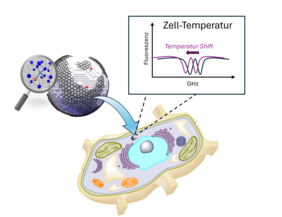Nanothermometry within living cells is an important field of physics, as the mechanisms of heat diffusion in such complex and dynamic environments remain poorly understood. Nanothermometry could provide new insights into cell biology and open new avenues for drug discovery.
An international team, including members of the University Ulm, Cardiff University University Stuttgart, University of Warwick, IOM Leipzig and the Max Planck Institute for Polymer Research has now reported nanothermometry with a precision down to 100 mK (52 mK outside cells) using optimized nanodiamonds and a more robust sensing protocol for the optically detected magnetic resonance spectra of nitrogen-vacancy centers.
These improved measurements minimize artifacts arising from electric field changes on the nanodiamond surface. Their studies focused on metabolic effects within macrophages. Previous research using various nanothermometers reported temperature variations of several Kelvins during metabolic stimulation findings that were controversially discussed. The new experiments, however, demonstrated that in their experimental setting, no significant temperature changes occur upon metabolic stimulation. This result is consistent with the heat diffusion law and expected physiological heating rates.
The results have been published in the journal Advanced Science:
Millikelvin Intracellular Nanothermometry with Nanodiamonds
https://doi.org/10.1002/advs.202511670

